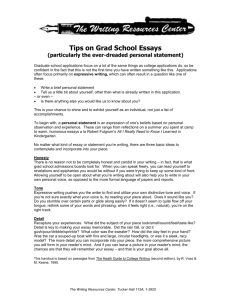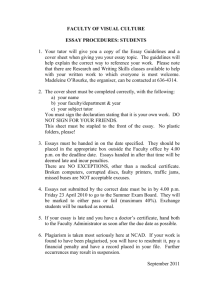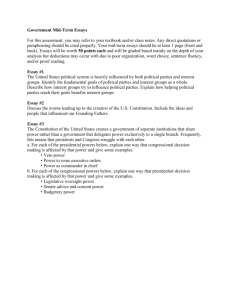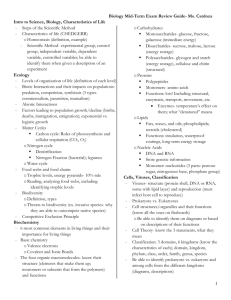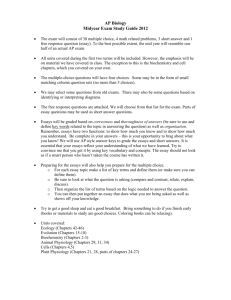Std_bio_mid_year_study_guide_2013.doc
advertisement
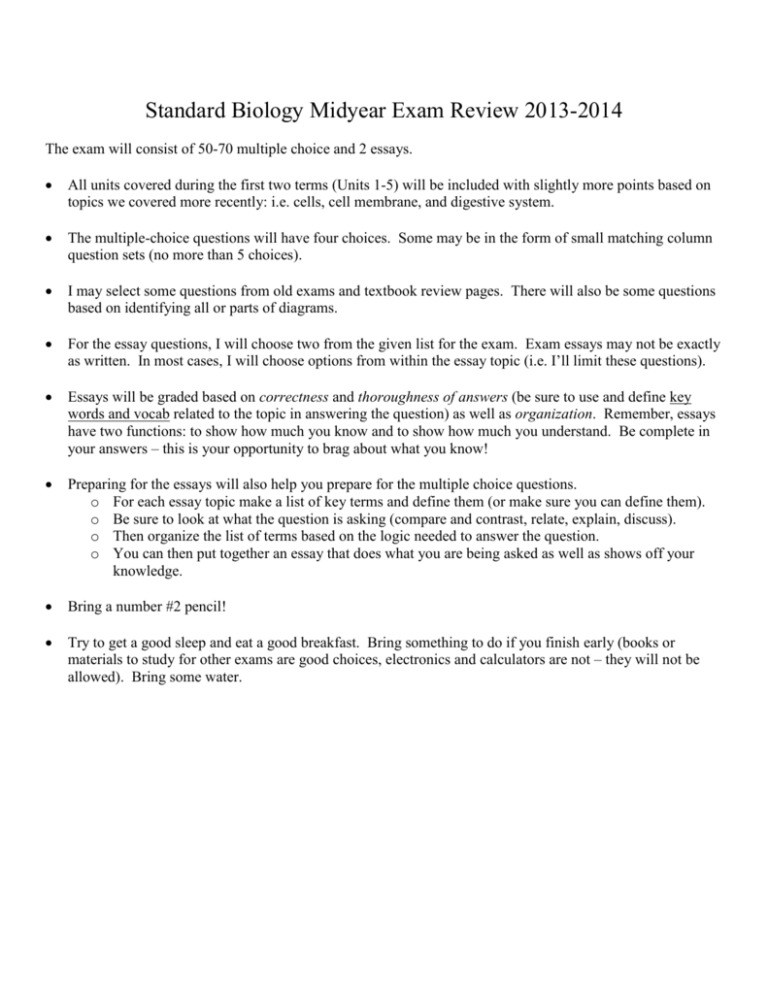
Standard Biology Midyear Exam Review 2013-2014 The exam will consist of 50-70 multiple choice and 2 essays. All units covered during the first two terms (Units 1-5) will be included with slightly more points based on topics we covered more recently: i.e. cells, cell membrane, and digestive system. The multiple-choice questions will have four choices. Some may be in the form of small matching column question sets (no more than 5 choices). I may select some questions from old exams and textbook review pages. There will also be some questions based on identifying all or parts of diagrams. For the essay questions, I will choose two from the given list for the exam. Exam essays may not be exactly as written. In most cases, I will choose options from within the essay topic (i.e. I’ll limit these questions). Essays will be graded based on correctness and thoroughness of answers (be sure to use and define key words and vocab related to the topic in answering the question) as well as organization. Remember, essays have two functions: to show how much you know and to show how much you understand. Be complete in your answers – this is your opportunity to brag about what you know! Preparing for the essays will also help you prepare for the multiple choice questions. o For each essay topic make a list of key terms and define them (or make sure you can define them). o Be sure to look at what the question is asking (compare and contrast, relate, explain, discuss). o Then organize the list of terms based on the logic needed to answer the question. o You can then put together an essay that does what you are being asked as well as shows off your knowledge. Bring a number #2 pencil! Try to get a good sleep and eat a good breakfast. Bring something to do if you finish early (books or materials to study for other exams are good choices, electronics and calculators are not – they will not be allowed). Bring some water. Units 1-4 To Be Included on Midyear Exam o Unit 1: The nature of science and life (Chapters 1, 15; Section 19-2) Scientific method Characteristics of living things Structure and function of viruses Theory of Natural Selection (Evolution) o Unit 2: Ecology (Chapters 3-5) How organisms acquire energy and their classifications Ecological pyramids, trophic levels, and food chains/webs Abiotic vs. biotic factors Niche vs. habitat Symbiosis Nutrient cycles (water, carbon, nitrogen, phosphorus) Population dynamics, growth, and capacity Biomes, succession o Unit 3: Intro to chemistry and the chemistry of water (Chapter 2) Atomic structure; isotopes and ions Bonding (ionic, covalent) Polarity; properties of water Mixtures/Solutions/Suspensions Acids and bases o Unit 3: Biochemistry and enzymes (Chapter 2) Carbon’s importance Structure and function of: carbohydrates, lipids, nucleic acids, and proteins Activation energy (and diagrams) in exothermic and endothermic reactions Catalysts and enzyme (structure and function) Enzyme regulation o Unit 3: Digestion (Sections 38-1, 38-2) Nutrients, vitamins, and minerals Protein, lipid, and carbohydrate digestion Chemical and mechanical digestion Digestive organs and their functions o Unit 4: Cell structure, cell types, cell membrane, and transport (Chapters 7, 18) Microscopes (safety and types) Cell theory Surface area to volume ratio Cell organelles (structure and function) Cell types (animal/plant, prokaryote/eukaryote) Cell specialization Standard Bio Mid Year Exam POSSIBLE ESSAY TOPICS 1. Name and explain the characteristics of life. Apply them to a living thing and give examples of how the organism accomplishes these characteristics. 2. Discuss the theory of Natural Selection (remember OCVSRS) and explain its significance in biology. Explain how Darwin used artificial selection as an analogy for Natural Selection. 3. Design a controlled experiment that tests the effect of temperature on enzymes. For this experiment: i. Present a hypothesis in the correct If/then format. ii. Explain your experimental procedure/methods (not step by step, a summary) iii. Describe what kinds of results you would expect, and the conclusions that can be drawn from those results. iv. Any supporting graphs or tables must be clear and properly labeled. 4. What properties of water make it an essential component of living things? In what ways is the presence of water essential for our survival? In your essay you must describe the structure of a water molecule (may be a drawing with some description) and how the structure of a water molecule leads to hydrogen bonding, and the other properties of water. Basically, describe how the function of water depends on its structure. 5. For the following items: a. Enzymes b. Small intestine i. Describe its structure ii. Explain its significance in biology, including how its presence affects our survival iii. Explain how its function depends on its structure 6. Describe the four groups of organic compounds (i.e. Macromolecules) using the following criteria: c. Briefly describe the structure of each. d. Explain why each is essential for life (consider all of the processes we’ve covered and which compounds take part in which processes). 7. Compare and contrast prokaryote and eukaryote cells. Compare and contrast plant and animal cells. Be able to discuss the function of the cell organelles. 8. Trace the flow of energy through an ecosystem by doing the following: a. Draw a food web. Describe how this is different from a food chain. b. Draw an ecological pyramid representing the direction in which the energy flows and the amount of energy passed on to the next trophic level. c. Label the organisms at different trophic levels as autotrophs, heterotrophs, consumers, producers, herbivores, carnivores, omnivores, detritivores, or decomposers.





